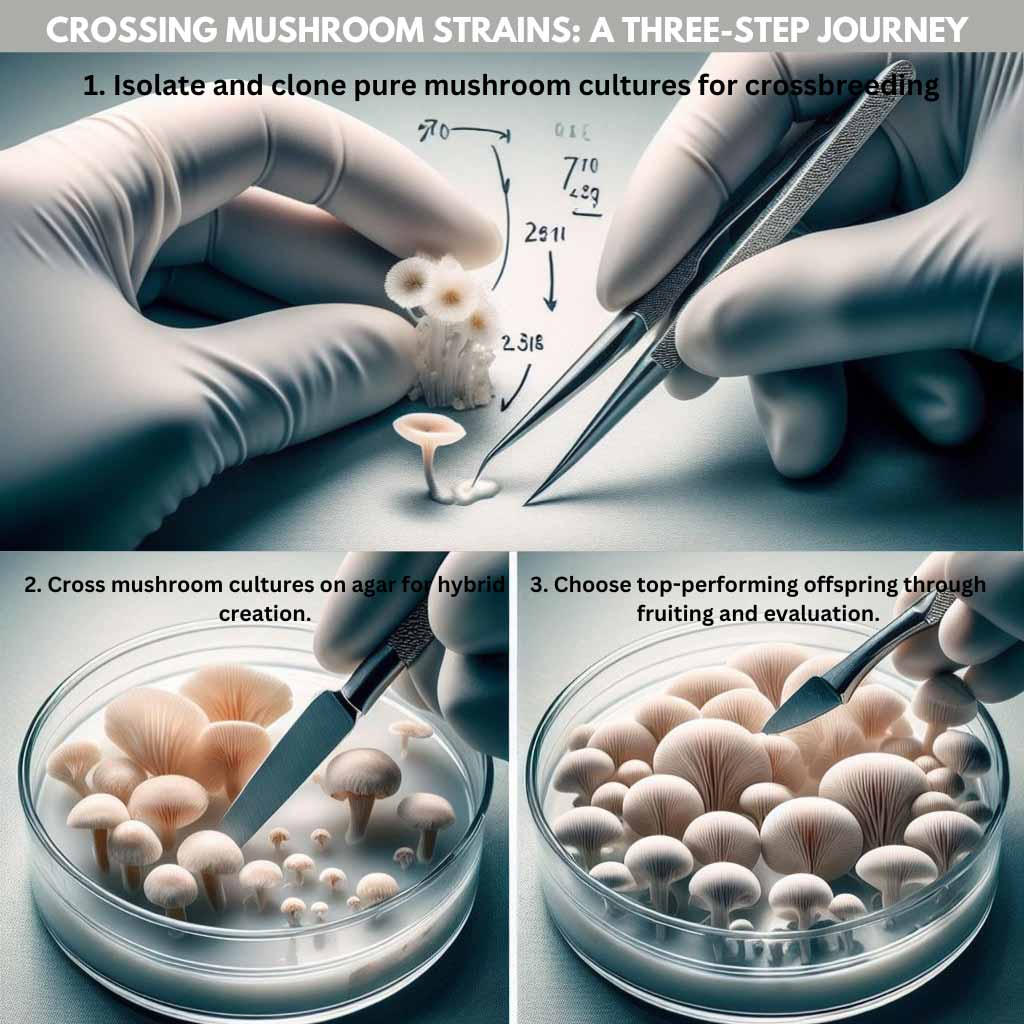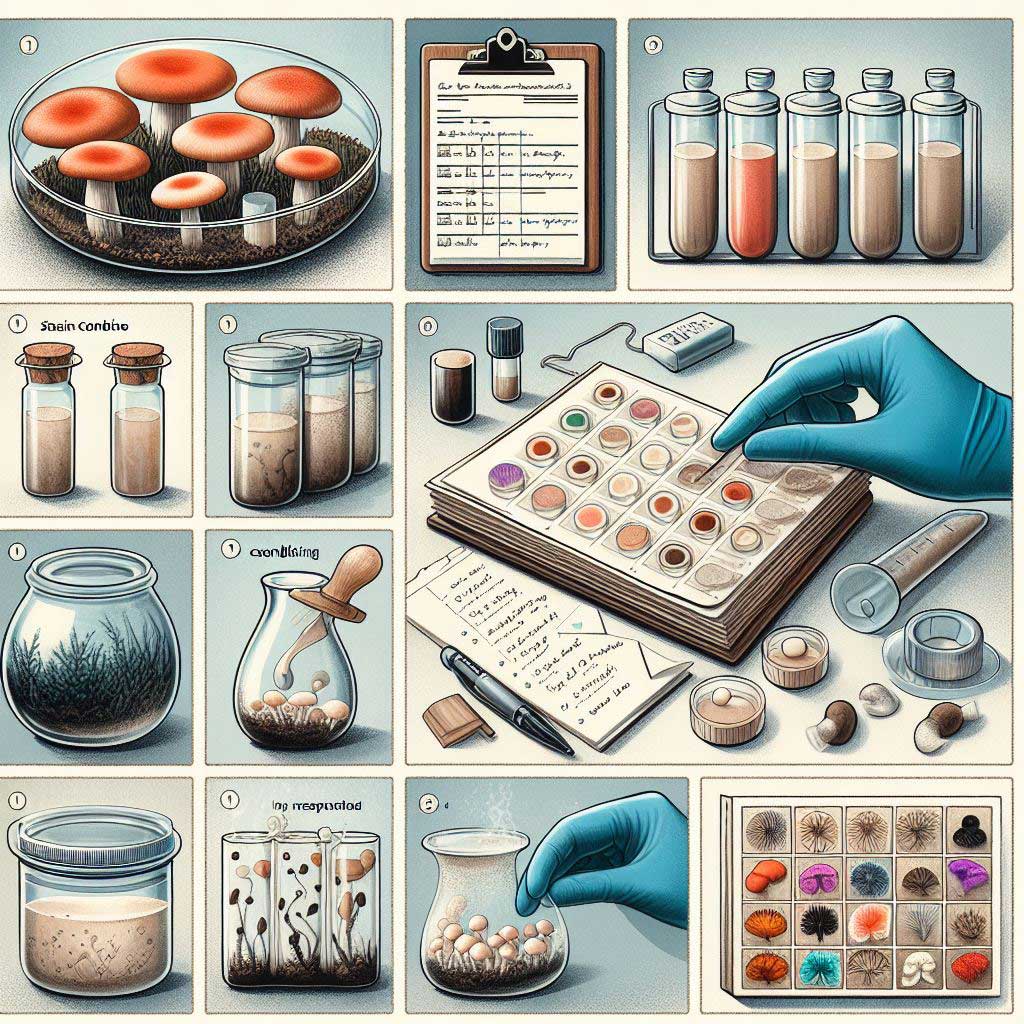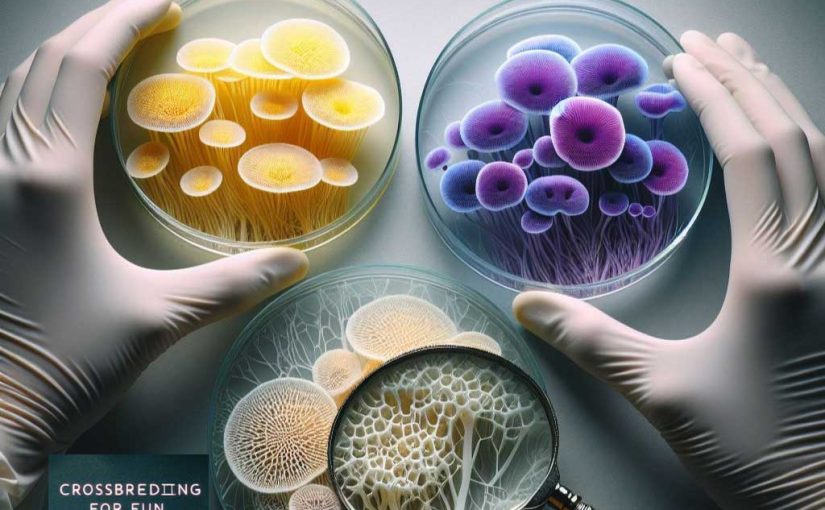Do you love growing mushrooms at home? Do you want to create your own unique varieties of mushrooms with different shapes, colors, flavors, and effects? If so, you should learn how to cross mushroom strains.
Crossing mushroom strains means mixing genes from different mushrooms to create a new strain with good qualities. Similar to how plant breeders create new varieties of flowers, fruits, and vegetables by cross-pollinating them.
Crossing mushroom strains can be a fun and rewarding hobby for mushroom enthusiasts. It can help improve mushroom crops and find unique types of mushrooms, enhancing quality and yield.
However, crossing mushroom strains is more challenging than it sounds. It requires some knowledge, skill, patience, and luck. This blog post will show you how to cross mushroom strains effectively. We will also give tips and tricks to help you succeed in your mushroom breeding adventure.
What You Need to Cross Mushroom Strains?
Before you start crossing mushroom strains, you will need some basic equipment and materials. Here is a list of what you need:
- Two or more strains of mushrooms: You can use any strains of mushrooms that you like, as long as they belong to the same species. For example, you can cross different strains of oyster mushrooms, but you can’t cross oyster mushrooms with shiitake mushrooms. You can buy mushroom spores or cultures online or from local mushroom growers.
- A sterile work area: You will need a clean, sterile place to work with your mushroom spores and cultures. You can use a glove box, a laminar flow hood, or a still air box. These are devices that create a sterile environment by filtering out any contaminants from the air. You can buy them online or make your own with some basic materials.
- A pressure cooker: You will need a pressure cooker to sterilize your substrates and jars. A pressure cooker kills bacteria, fungi, and other microorganisms in mushroom cultures using high pressure and temperature. You can buy a pressure cooker online or from a local store.
- Substrates and jars: You will need some substrates and jars to grow your mushroom cultures. Substrates are the materials that provide nutrients and moisture for your mushrooms. Jars are the containers that hold your substrates and cultures. You can use any substrates that are suitable for your mushroom strains, such as grains, sawdust, straw, or coffee grounds. You can use any jars that are clean and have lids with holes for air exchange, such as mason jars or plastic bottles.
- A syringe and a needle: You will need a syringe and a needle to transfer your mushroom spores and cultures. A syringe is a device that can hold and inject liquids. A needle is a thin metal tube piercing through substrates and jars. You can buy a syringe and a needle online or from a local pharmacy.
- A scalpel and a petri dish: You will need a scalpel and a petri dish to isolate and clone your mushroom strains. A scalpel is a small knife that can cut through mushroom tissue. A petri dish is a shallow glass or plastic dish that can hold agar. Agar is a gel-like substance that can support the growth of mushroom cultures. You can buy a scalpel and a petri dish online or from a local lab supply store.
- A marker and a label: You will need a marker and a label to mark and identify your mushroom strains and cultures. A marker is a pen that can write on substrates and jars. A label is a piece of paper or sticker that can stick to substrates and jars. You can use any marker and label that is clear and durable.
How to Cross Mushroom Strains? Easy 3 steps
Now that you have everything you need, you are ready to cross mushroom strains. Here are the steps to follow:

Step 1: Isolate and Clone Your Mushroom Strains
The first step to cross mushroom strains is to isolate and clone your mushroom strains. This means you need to separate your mushroom strains’ individual spores or cells and grow them into pure cultures. This will ensure that you have a single genetic line of each strain, which will make it easier to cross them later.
To isolate and clone your mushroom strains, you will need to do the following:
- Prepare your substrates and jars: Fill your jars with your substrates and cover them with lids. Make sure to leave some space for air and water in your jars. Sterilize your substrates and jars in your pressure cooker for at least 15 minutes at 15 psi. Let them cool down completely before opening them.
- Prepare your agar and petri dishes: Mix some agar powder with water in a pot and bring it to a boil. Pour the agar solution into your Petri dishes and let it solidify. Sterilize your agar and Petri dishes in your pressure cooker for at least 15 minutes at 15 psi. Let them cool down completely before opening them.
- Prepare your syringe and needle: Fill your syringe with sterile water and attach your needle to it. Sterilize your syringe and needle in your pressure cooker for at least 15 minutes at 15 psi. Let them cool down completely before using them.
- Prepare your scalpel: Sterilize your scalpel in your pressure cooker for at least 15 minutes at 15 psi. Let it cool down completely before using it.
- Isolate your mushroom spores: Take one of your mushroom strains and cut off a small piece of the cap with your scalpel. Place the cap piece on a clean surface and gently scrape off some of the spores with your needle. Transfer the spores to your syringe by sucking them up with the water. Repeat this process for each of your mushroom strains. Label your syringes with your marker and label.
- Inoculate your substrates with your mushroom spores: Take one of your jars and shake it well to loosen the substrate. Remove the lid and inject some of the spore solution from one of your syringes into the substrate. Replace the lid and shake the jar again to distribute the spores. Repeat this process for each of your jars and syringes. Label your jars with your marker and label.
- Incubate your jars: Place your jars in a warm and dark place, such as a closet or a cabinet. Keep them at a temperature of about 25°C (77°F) and a humidity of about 80%. Check on them every few days and look for signs of growth, such as white mycelium or fuzzy patches. Depending on your mushroom strains and substrates, this may take anywhere from a few days to a few weeks.
- Clone your mushroom cultures: Once your mushroom cultures fully colonize your jars, you can clone them to get pure cultures. To do this, you will need to do the following:
- Prepare your work area: Clean and sterilize your work area with some alcohol or bleach. Set up your sterile device, such as your glove box, laminar flow hood, or still air box. Put on some gloves and a mask to protect yourself from any contaminants.
- Transfer your mushroom cultures to your agar: Open one of your jars inside your sterile device. Take your scalpel and cut out a small piece of the mushroom culture from the substrate. Transfer the culture piece to one of your Petri dishes and press it gently onto the agar. Close the petri dish and seal it with some tape. Repeat this process for each of your jars and petri dishes. Label your petri dishes with your marker and label.
- Incubate your petri dishes: Place your petri dishes in a warm and dark place, such as a closet or a cabinet. Keep them at a temperature of about 25°C (77°F) and a humidity of about 80%. Check on them every few days and look for signs of growth, such as white mycelium or fuzzy patches. Depending on your mushroom strains and agar, this may take anywhere from a few days to a few weeks.
Congratulations, you have successfully isolated and cloned your mushroom strains. You now have pure cultures of each strain, which you can use to cross them in the next step.
Step 2: Cross Your Mushroom Strains
To cross mushroom strains, the second step involves mixing the genetic material of two or more strains of mushrooms. This will result in a new strain with a unique combination of traits. You can achieve this by mating the mushroom cultures on agar and selecting the most favorable offspring.
To cross your mushroom strains, you will need to do the following:
- Prepare your work area: Clean and sterilize your work area with some alcohol or bleach. Set up your sterile device, such as your glove box, laminar flow hood, or still air box. Put on some gloves and a mask to protect yourself from any contaminants.
- Cross your mushroom cultures on agar: Take two of your Petri dishes and open them inside your sterile device. Take your scalpel and cut out a small piece of each mushroom culture from the agar. Transfer the culture pieces to a new petri dish and press them gently onto the agar, close to each other. Close the petri dish and seal it.
- Tape: Repeat this process for each pair of mushroom strains that you want to cross. Label your petri dishes with your marker and label.
- Incubate your petri dishes: Place your petri dishes in a warm and dark place, such as a closet or a cabinet. Keep them at a temperature of about 25°C (77°F) and a humidity of about 80%. Check on them every few days and look for signs of mating, such as different colors, textures, or patterns on the agar. Depending on your mushroom strains and agar, this may take anywhere from a few days to a few weeks.
Congratulations, you have successfully crossed your mushroom strains. You now have hybrid cultures of each pair of strains, which you can use to select the best offspring in the next step.
Step 3: Select the Best Offspring
Selecting the best offspring is the third and final step to cross mushroom strains. This means you need to test the hybrid cultures of each pair of strains and choose the ones with the most desirable traits. This is done by growing the hybrid cultures on substrates and observing their growth, appearance, and potency.
To select the best offspring, you will need to do the following:
- Prepare your substrates and jars: Fill your jars with your substrates and cover them with lids. Make sure to leave some space for air and water in your jars. Sterilize your substrates and jars in your pressure cooker for at least 15 minutes at 15 psi. Let them cool down completely before opening them.
- Prepare your syringe and needle: Fill your syringe with sterile water and attach your needle to it. Sterilize your syringe and needle in your pressure cooker for at least 15 minutes at 15 psi. Let them cool down completely before using them.
- Inoculate your substrates with your hybrid cultures: Take one of your Petri dishes and open it inside your sterile device. Take your scalpel and cut out a small piece of one of the hybrid cultures from the agar. Transfer the culture piece to your syringe by sucking it up with the water. Repeat this process for each of your hybrid cultures. Label your syringes with your marker and label. Take one of your jars and shake it well to loosen the substrate. Remove the lid and inject some of the culture solution from one of your syringes into the substrate. Replace the lid and shake the jar again to distribute the culture. Repeat this process for each of your jars and syringes. Label your jars with your marker and label.
- Incubate your jars: Place your jars in a warm and dark place, such as a closet or a cabinet. Keep them at a temperature of about 25°C (77°F) and a humidity of about 80%. Check on them every few days and look for signs of growth, such as white mycelium or fuzzy patches. Depending on your hybrid cultures and substrates, this may take anywhere from a few days to a few weeks.
- Fruit your jars: Once your hybrid cultures fully colonize your jars, you can fruit them to produce mushrooms. To do this, you will need to do the following:
- Prepare your fruiting chamber: You will need a large plastic container with a lid, such as a storage bin or a cooler. Drill some holes on the sides and the container lid for air exchange. Fill the bottom of the container with some perlite, which is a porous material that can retain water and humidity. Wet the perlite with some water and drain the excess. Place a rack or a tray on top of the perlite, which will hold your jars.
- Transfer your jars to your fruiting chamber: Take one of your jars and remove the lid. Place the jar on the rack or the tray in your fruiting chamber. Repeat this process for each of your jars. Close the lid of the fruiting chamber and place it in a bright and cool place, such as a window sill or a basement. Keep the temperature at about 20°C (68°F) and the humidity at about 90%. Mist the inside of the fruiting chamber with some water every day to maintain the humidity. Check on your jars every day and look for signs of fruiting, such as small pins or bumps on the surface of the substrate. Depending on your hybrid cultures and substrates, this may take anywhere from a few days to a few weeks.
- Harvest your mushrooms: Once grown to a suitable size, you can harvest them by gently twisting and pulling them from the substrate. You can also cut them with a knife or scissors if you prefer. Store your mushrooms in a paper bag or a cardboard box in the refrigerator or the freezer. You can also dry them in a dehydrator or an oven for long-term storage.
Congratulations, you have successfully selected the best offspring. You now have mushrooms of your new strain, which you can enjoy or share with others.
Tips and Tricks to Cross Mushroom Strains
Here are some tips and tricks to help you cross mushroom strains more effectively:

- Experiment with different combinations of strains: You can try crossing different strains of mushrooms to see what kind of hybrids you can create. You can also try crossing more than two strains at a time by placing more than two culture pieces on the same petri dish. You might discover some surprising and interesting results.
- Keep track of your experiments: You should keep a record of your experiments, such as the names and sources of your strains, the dates and methods of your isolation, cloning, crossing, and selection, and the results and observations of your growth, fruiting, and harvesting. You can use a notebook, a spreadsheet, or a database to store your data. This will help you remember and analyze your experiments and replicate or improve them in the future.
- Label your materials clearly: You should label your materials clearly, such as your syringes, jars, petri dishes, and mushrooms, with your marker and label. You should include the names and codes of your strains, the dates of your inoculation, fruiting, and harvesting, and any other relevant information. This will help you avoid confusion and mistakes, as well as to identify and compare your materials.
- Be patient and persistent: Crossing mushroom strains can be a challenging and time-consuming process. It may take several attempts and trials to get the desired results. You may also encounter some failures and setbacks, such as contamination, poor growth, or undesirable traits. You should not give up or get discouraged but rather learn from your experiences and try again. You will eventually succeed and enjoy the fruits of your labor.
Conclusion
Crossing mushroom strains is a fun and rewarding hobby for mushroom enthusiasts. It can also be a way to improve the quality and yield of your mushroom crops, as well as to discover new and exciting types of mushrooms that you can’t find anywhere else.
This blog post showed you how to cross mushroom strains effectively. We also gave you some tips and tricks to help you succeed in your mushroom breeding adventure.
If you have any questions, please leave them below. We would love to hear from you.
Happy mushroom growing!
